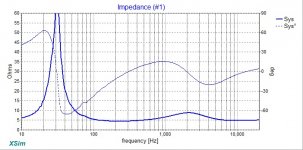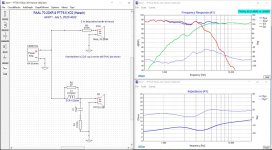Over in the PTT6.5 and RS28F TL thread, I was very impressed with the Purifi's midrange and bass abilities, so when I had the cabinets built I asked my cabinet maker to build a second set of baffles with a cutout for the RAAL 70-20xr ribbon tweeter. As I am waiting for the TL to get re-worked/re-built due to an improper seal in the internal channels I started to look at the RAAL 70-20xr as a pairing to pass the time by designing a XO. Since I don't have a back cabinet yet, I mounted everything open baffle figuring I will just work on the XO as it will be at 3500Hz, far enough away from where the open baffle effects need to be considered.
Here is the TL cabinet that is getting built (aiming for -3dB at 36Hz):
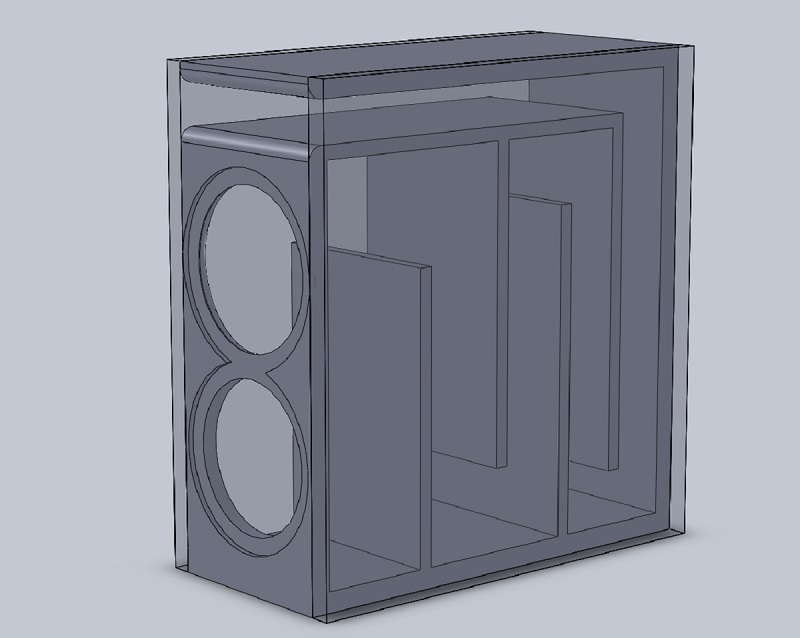
So I installed the drivers on the spare baffle - everything went together nicely. I installed some MakerBeam channels to provide temporary support for the measurements. The initial measurements and XO started off in the other thread, but they turned out so good I thought it deserved its own titled thread.
Here is the setup:
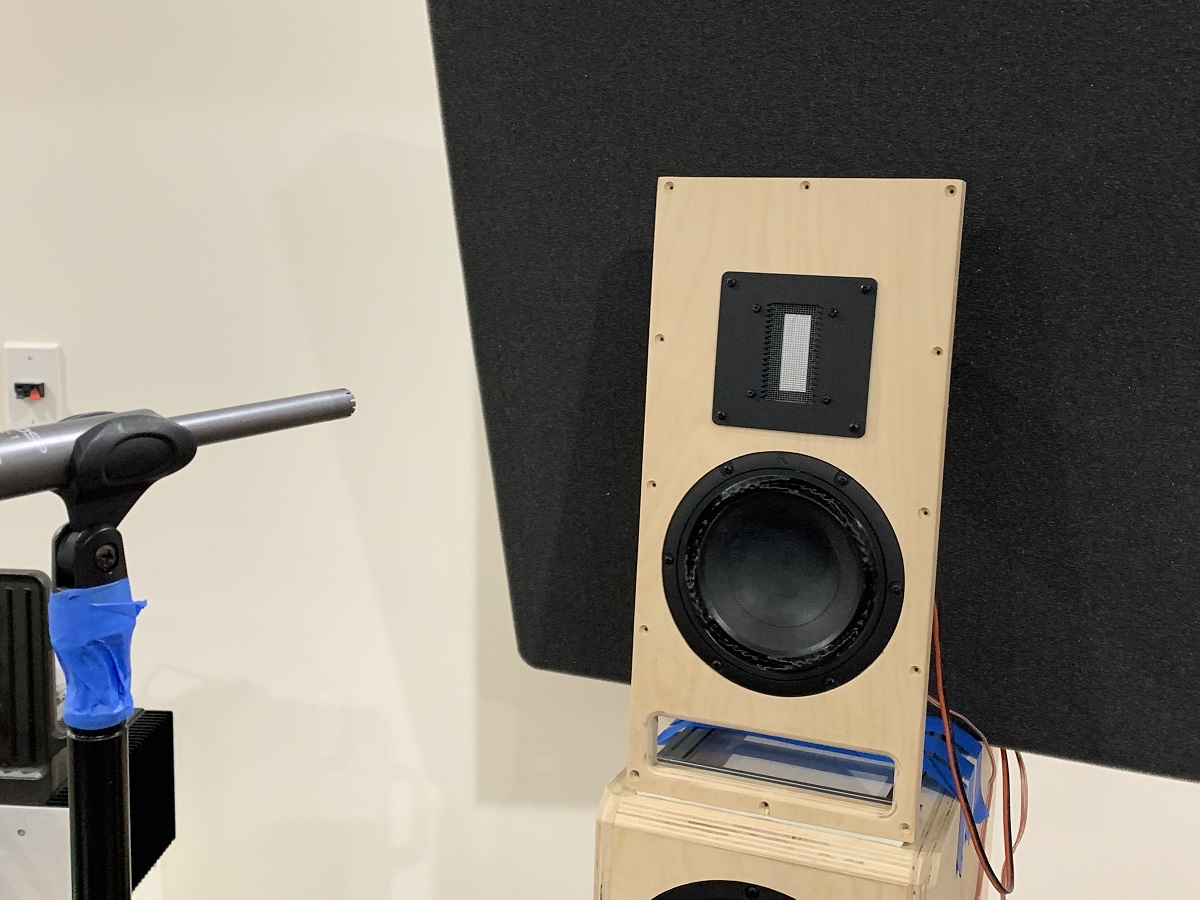
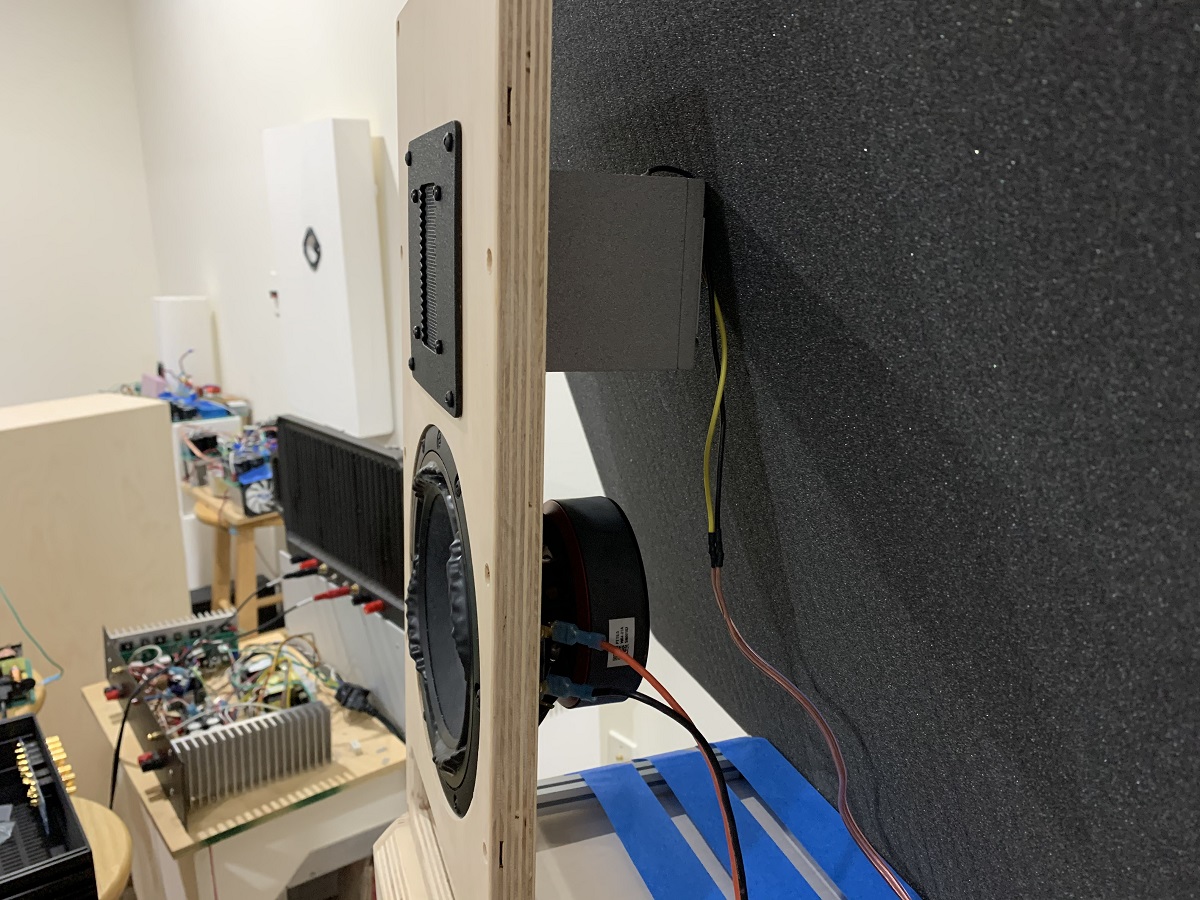
My reasoning for the 3500Hz crossover point was mainly driven by the PTT6.5's natural falloff there so I wanted to take advantage of a similar higher order slope using just a few simple components with 2nd order electrical and maybe 4th order acoustic. The Purifi is rated 88.5 dB at 2.83v and the RAAL has several transformer taps to allow adjustment of sensitivity without using a lot of resistors. The 12ohm tap is stated as about 89dB sensitivity so I opted for that. The factory recommended single crossover component was 4.7uF for a 1700Hz 4th order acoustic and 2nd order electrical. I was thinking use 2.2uF for 3400Hz and go for a 4th order XO circa 3500Hz.
So I connect the drivers to measure the raw response for the FRD files to load into Xsim to do the XO simulation. I used a 2.2uF cap in series with the RAAL as it cannot be driven by directly since it presents a 0.6ohm load the amp at DC. I proceed to take the usual "raw" data sets of (1) tweeter only; (2) woofer only; and (3) tweeter and woofer in parallel. This is to do the acoustic interferometry to adjust the relative acoustic center delays (due to voice coil location differences and baffle/bezel offsets). What came out of the "raw" data was almost a perfect "accidental" crossover that looked like it had been worked on laboriously. The two drivers are apparently, ideally matched - like they were meant for each other.
I was having issues with my SPL calibtration meter (reads about 5dB too high relative to know standards - a new better one is on order). So for now, please ignore the absolute SPL on the vertical axis. Data was taken with 2.0vrms (set at 1kHz) and 0.5m away on tweeter axis.
Here was the measured "raw" response for the tweeter (green), woofer (red) and combined (blue):
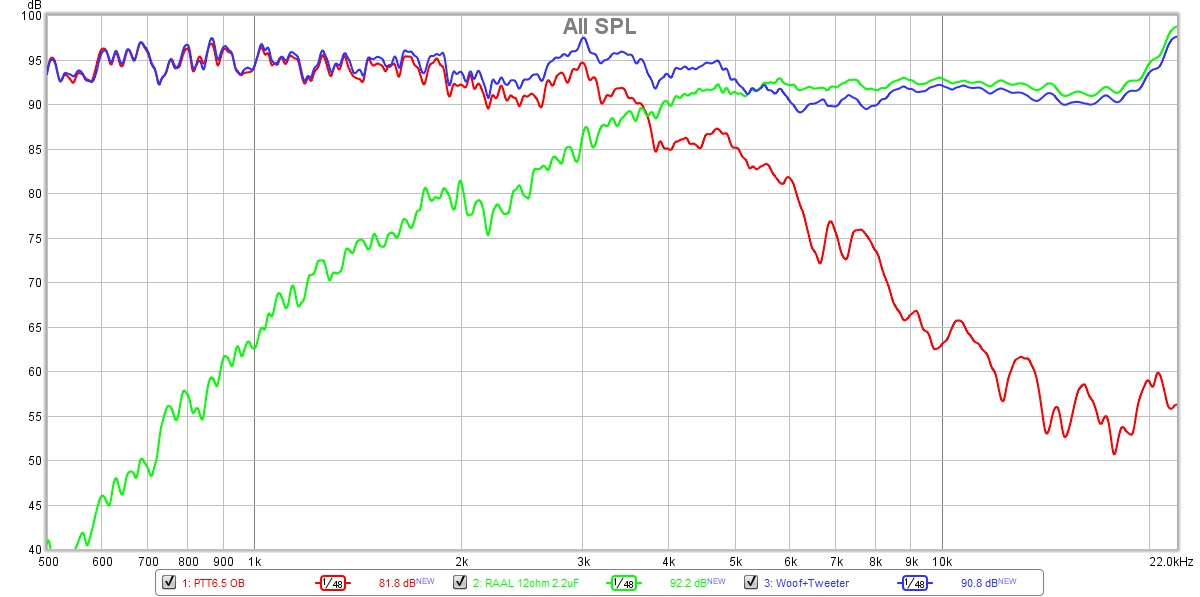
The above doesn't look like any other "raw" set of woofer and tweeter data I have ever seen before... Almost a perfect auto-crossover (only one component being the mandatory 2.2uF coupling cap for the tweeter).
Raw system measured acoustical phase:
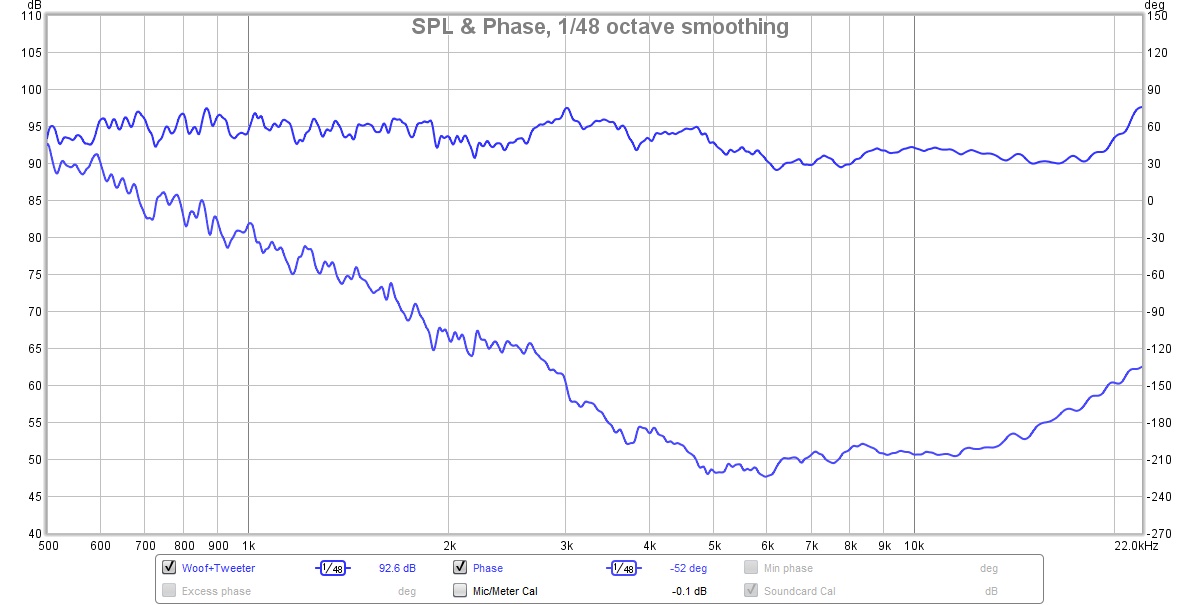
Raw system harmonic distortion (there are some peaks from the RAAL at 1.7k, 2.6k, and 3.4kHz that I will need to look into more, but they are 2nd harmonic so not terribly high or bad sounding):
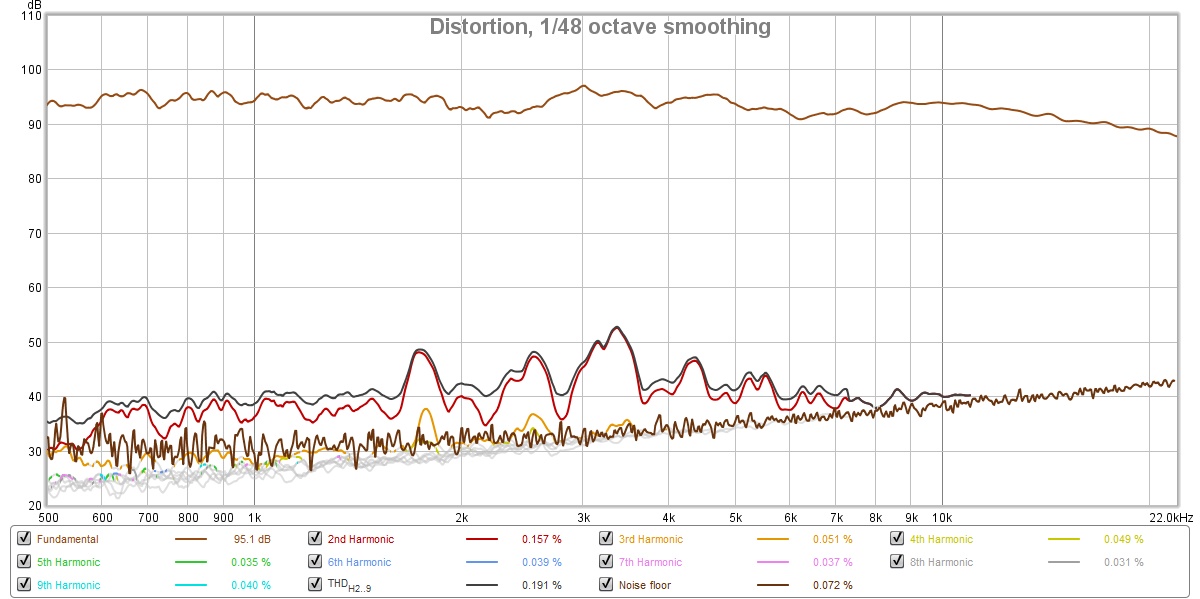
and this was the raw Step Response:
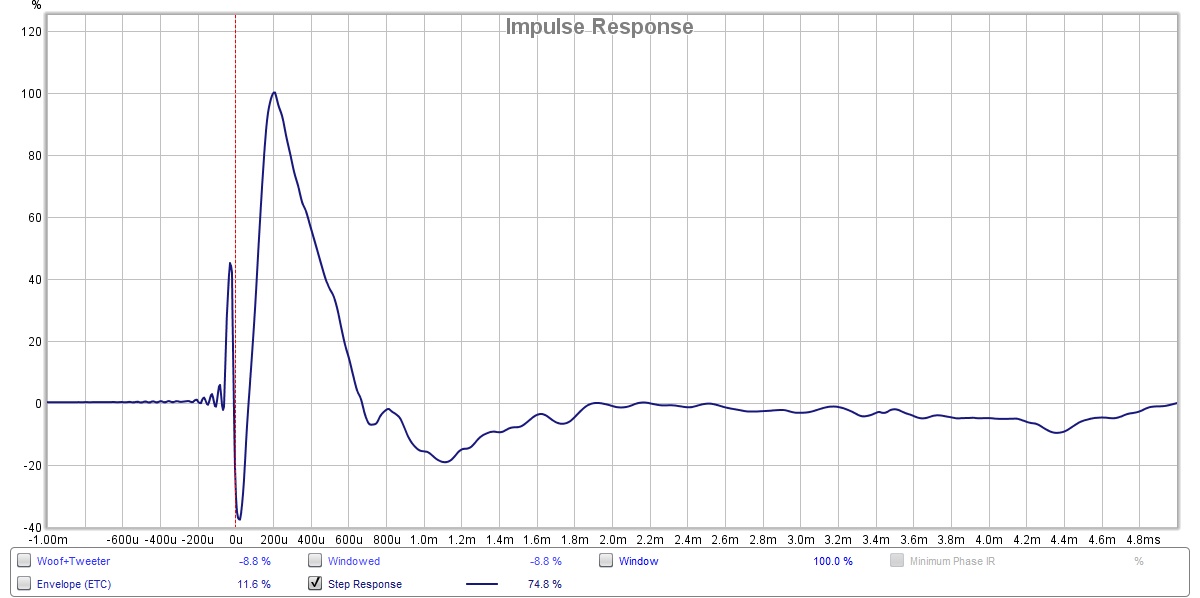
Using the FRD's from the above and ZMA's from a DATS, I loaded everthing into Xsim and was able to get what I think must by a hybrid 1st order/2nd order XO where at the crossover frequency it is -6dB/octave and changes smoothly to -12 to -18dB/octave farther away. This allowed me to use the same absolute polarity for both drivers. Applying just a 0.33mH coil with a 6.8ohm in paralle for a high shelf filter, and a 6.8uF and 0.51ohm in series across the woofer terminals to quash out the stuff above 3.5khz, I was able to achieve this simple XO (note there is a 2.2uF for the RAAL that is part of the raw FRD so not shown):
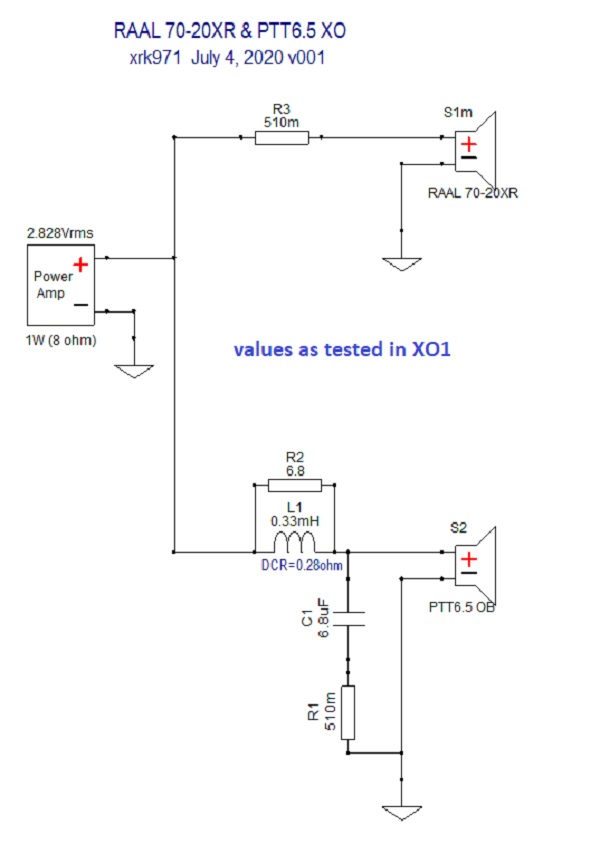
I built this prototype XO using parts from my crossover development kit and Wago connectors in 10 minutes (highly recommended to have a complete kit of all major inductor/cap/resistor values on hand - a kit like this costs under $200 and allows what if XO's to be tried out and verified instantly without waiting 3-5 days for parts to come in):
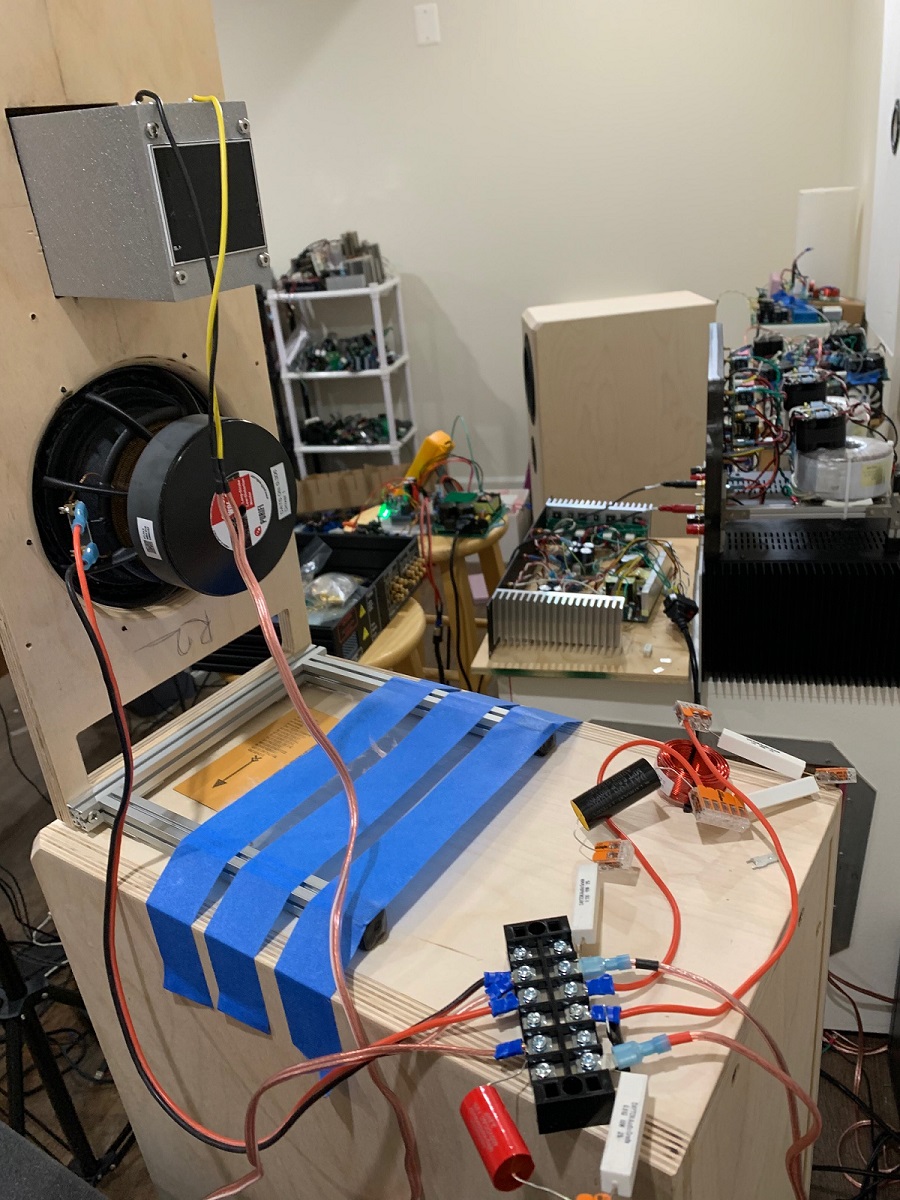
And here is how the predicted (blue) and measured response (orange) looks:
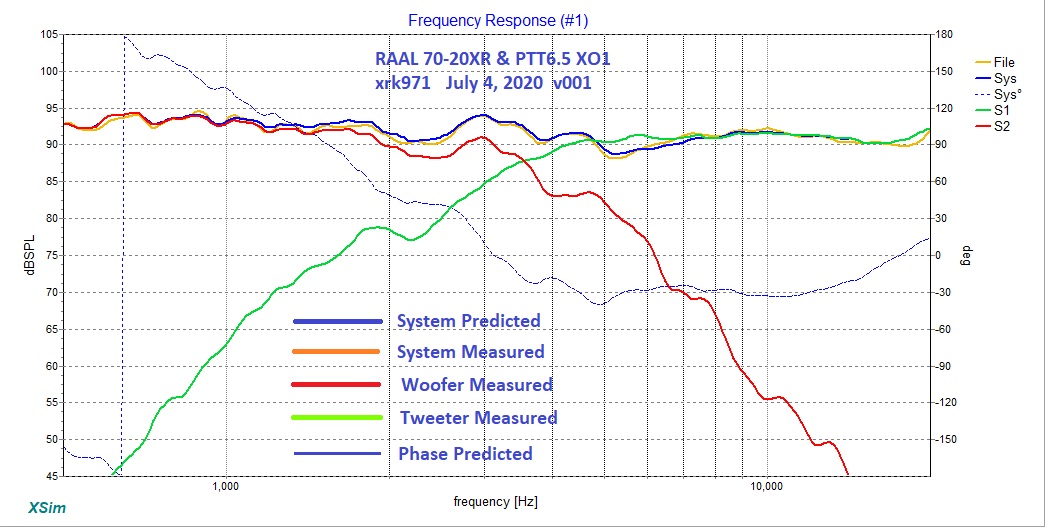
This is the predicted Impedance for the system (note that as an open baffle there is only one peak on the woofer rather than two for a vented alignment - another reason to use a TL is to really flatten the high impedance peak here):
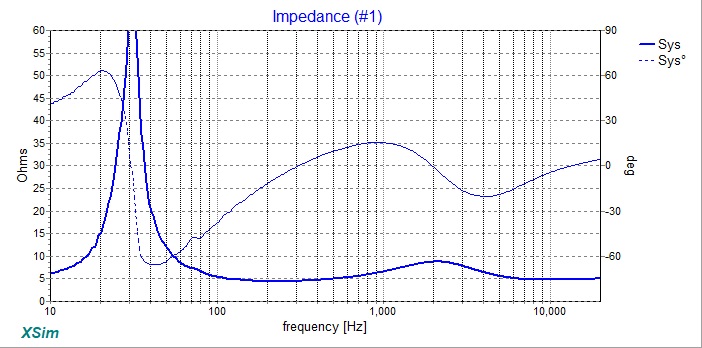
Here is the measured data at higher resolution 1/48th octave smoothing:
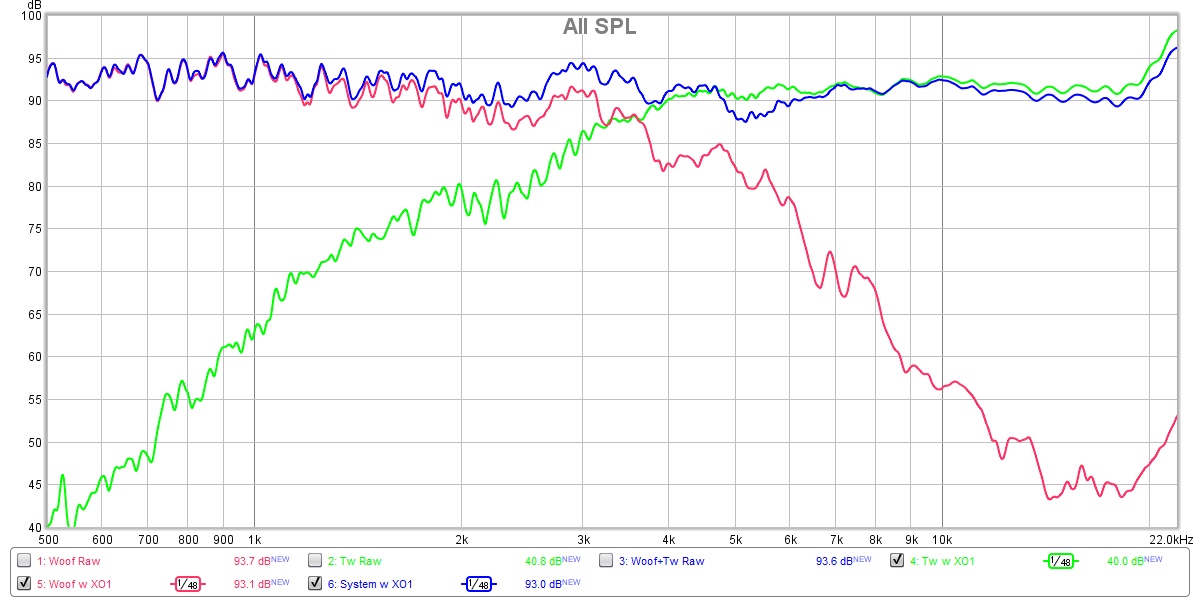
Here is the measured acoustical phase:
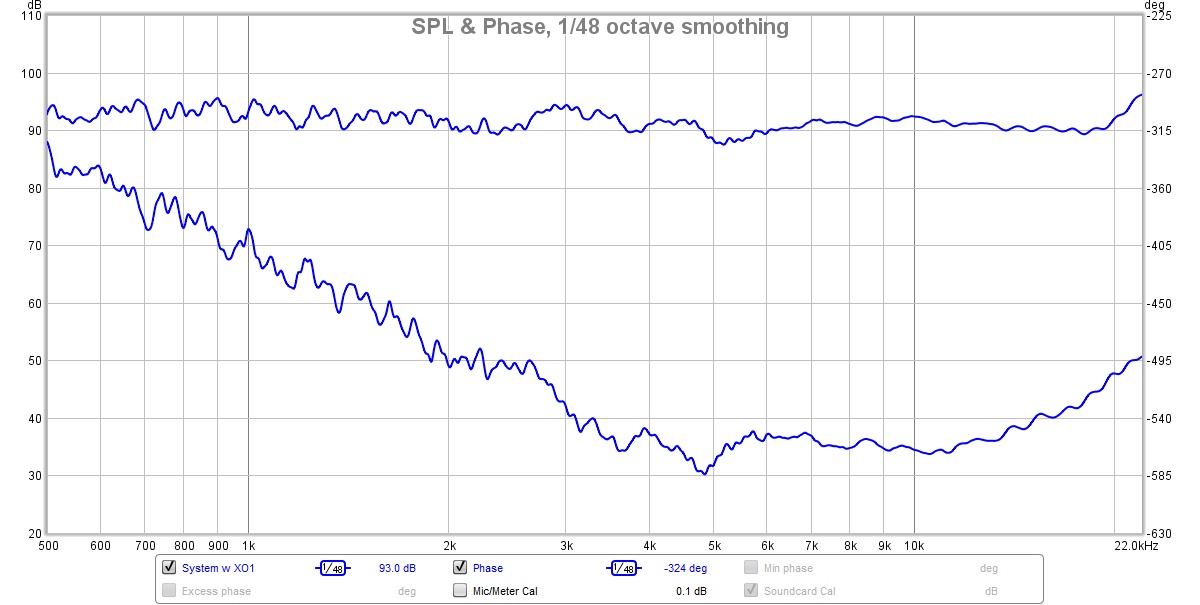
Here is the measured step response:
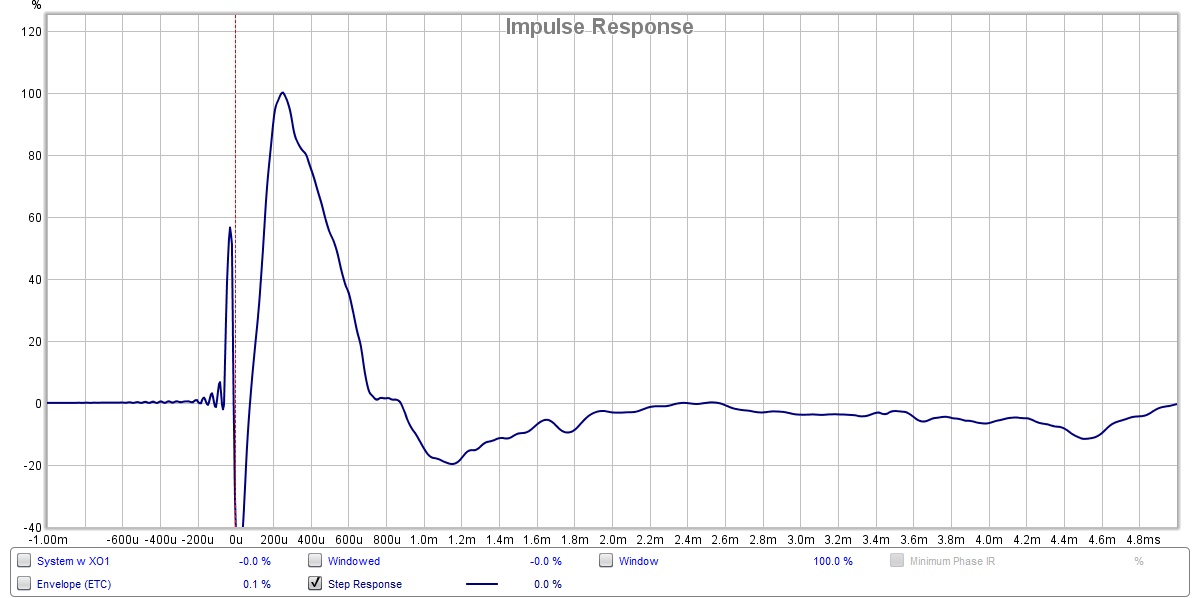
The measurements all match the simulations on Xsim almost perfectly. I am very confident that the crossover simulator is working well and I can refine this even further. This is XO1 and looks and sounds unbelievably good.
You know a new speaker sounds exceptional when you forgo sleep to listen to reference tracks in the wee hours of the night. I listened to this list and was very impressed. I used my 10F/RS225 TL on the left channel to help balance out the bass to give some weight to the bass that will come later once I put the baffle on a TL cabinet. But for now, the PTT6.5 and RAAL combo sound great as an OB. The combo provides a lifellike realism with lots detail, yet they are not harsh or fatiguing. I feel a sense of emotion from the performance really coming through. A beautiful sounding combo.
Playlist:
Yuri Honing Trio "Walking on the Moon"
Suzanne Vega "Rosemary"
Natalie Merchant "Maggie Said"
Ahmad Jamal "Autumn Rain"
Omer Avital "Maroc"
Circuit Bent "Orchestrality"
Eagles "Hotel California"
Steely Dan "Hey Nineteen"
Metallica "Enter Sandman"
Anne Bisson "September in Montreal"
Chris Brubeck "In Your Own Sweet Way"
The Who "See Mee Feel Me Listening to You"
Gordon Goodwin's Big Phat Band "Garaje Gato"
Norah Jones "Burn"
All I can say is that this combo really shines and shows a marriage made in heaven for these two drivers. These RAALs are on loan, and I am seriously thinking to myself that I will need to get myself a pair. 🙂
Here is the TL cabinet that is getting built (aiming for -3dB at 36Hz):
So I installed the drivers on the spare baffle - everything went together nicely. I installed some MakerBeam channels to provide temporary support for the measurements. The initial measurements and XO started off in the other thread, but they turned out so good I thought it deserved its own titled thread.
Here is the setup:
My reasoning for the 3500Hz crossover point was mainly driven by the PTT6.5's natural falloff there so I wanted to take advantage of a similar higher order slope using just a few simple components with 2nd order electrical and maybe 4th order acoustic. The Purifi is rated 88.5 dB at 2.83v and the RAAL has several transformer taps to allow adjustment of sensitivity without using a lot of resistors. The 12ohm tap is stated as about 89dB sensitivity so I opted for that. The factory recommended single crossover component was 4.7uF for a 1700Hz 4th order acoustic and 2nd order electrical. I was thinking use 2.2uF for 3400Hz and go for a 4th order XO circa 3500Hz.
So I connect the drivers to measure the raw response for the FRD files to load into Xsim to do the XO simulation. I used a 2.2uF cap in series with the RAAL as it cannot be driven by directly since it presents a 0.6ohm load the amp at DC. I proceed to take the usual "raw" data sets of (1) tweeter only; (2) woofer only; and (3) tweeter and woofer in parallel. This is to do the acoustic interferometry to adjust the relative acoustic center delays (due to voice coil location differences and baffle/bezel offsets). What came out of the "raw" data was almost a perfect "accidental" crossover that looked like it had been worked on laboriously. The two drivers are apparently, ideally matched - like they were meant for each other.
I was having issues with my SPL calibtration meter (reads about 5dB too high relative to know standards - a new better one is on order). So for now, please ignore the absolute SPL on the vertical axis. Data was taken with 2.0vrms (set at 1kHz) and 0.5m away on tweeter axis.
Here was the measured "raw" response for the tweeter (green), woofer (red) and combined (blue):
The above doesn't look like any other "raw" set of woofer and tweeter data I have ever seen before... Almost a perfect auto-crossover (only one component being the mandatory 2.2uF coupling cap for the tweeter).
Raw system measured acoustical phase:
Raw system harmonic distortion (there are some peaks from the RAAL at 1.7k, 2.6k, and 3.4kHz that I will need to look into more, but they are 2nd harmonic so not terribly high or bad sounding):
and this was the raw Step Response:
Using the FRD's from the above and ZMA's from a DATS, I loaded everthing into Xsim and was able to get what I think must by a hybrid 1st order/2nd order XO where at the crossover frequency it is -6dB/octave and changes smoothly to -12 to -18dB/octave farther away. This allowed me to use the same absolute polarity for both drivers. Applying just a 0.33mH coil with a 6.8ohm in paralle for a high shelf filter, and a 6.8uF and 0.51ohm in series across the woofer terminals to quash out the stuff above 3.5khz, I was able to achieve this simple XO (note there is a 2.2uF for the RAAL that is part of the raw FRD so not shown):
I built this prototype XO using parts from my crossover development kit and Wago connectors in 10 minutes (highly recommended to have a complete kit of all major inductor/cap/resistor values on hand - a kit like this costs under $200 and allows what if XO's to be tried out and verified instantly without waiting 3-5 days for parts to come in):
And here is how the predicted (blue) and measured response (orange) looks:
This is the predicted Impedance for the system (note that as an open baffle there is only one peak on the woofer rather than two for a vented alignment - another reason to use a TL is to really flatten the high impedance peak here):
Here is the measured data at higher resolution 1/48th octave smoothing:
Here is the measured acoustical phase:
Here is the measured step response:
The measurements all match the simulations on Xsim almost perfectly. I am very confident that the crossover simulator is working well and I can refine this even further. This is XO1 and looks and sounds unbelievably good.
You know a new speaker sounds exceptional when you forgo sleep to listen to reference tracks in the wee hours of the night. I listened to this list and was very impressed. I used my 10F/RS225 TL on the left channel to help balance out the bass to give some weight to the bass that will come later once I put the baffle on a TL cabinet. But for now, the PTT6.5 and RAAL combo sound great as an OB. The combo provides a lifellike realism with lots detail, yet they are not harsh or fatiguing. I feel a sense of emotion from the performance really coming through. A beautiful sounding combo.
Playlist:
Yuri Honing Trio "Walking on the Moon"
Suzanne Vega "Rosemary"
Natalie Merchant "Maggie Said"
Ahmad Jamal "Autumn Rain"
Omer Avital "Maroc"
Circuit Bent "Orchestrality"
Eagles "Hotel California"
Steely Dan "Hey Nineteen"
Metallica "Enter Sandman"
Anne Bisson "September in Montreal"
Chris Brubeck "In Your Own Sweet Way"
The Who "See Mee Feel Me Listening to You"
Gordon Goodwin's Big Phat Band "Garaje Gato"
Norah Jones "Burn"
All I can say is that this combo really shines and shows a marriage made in heaven for these two drivers. These RAALs are on loan, and I am seriously thinking to myself that I will need to get myself a pair. 🙂
Attachments
Last edited:
Adding a 2.1in delay (move back behind woofer) via stepped baffle or waveguide to RAAL wil enable a transient perfect Harsch XO similar to the RS28F in a waveguide. Very simple crossover, just a change to C1 and R2 and delay tweeter.
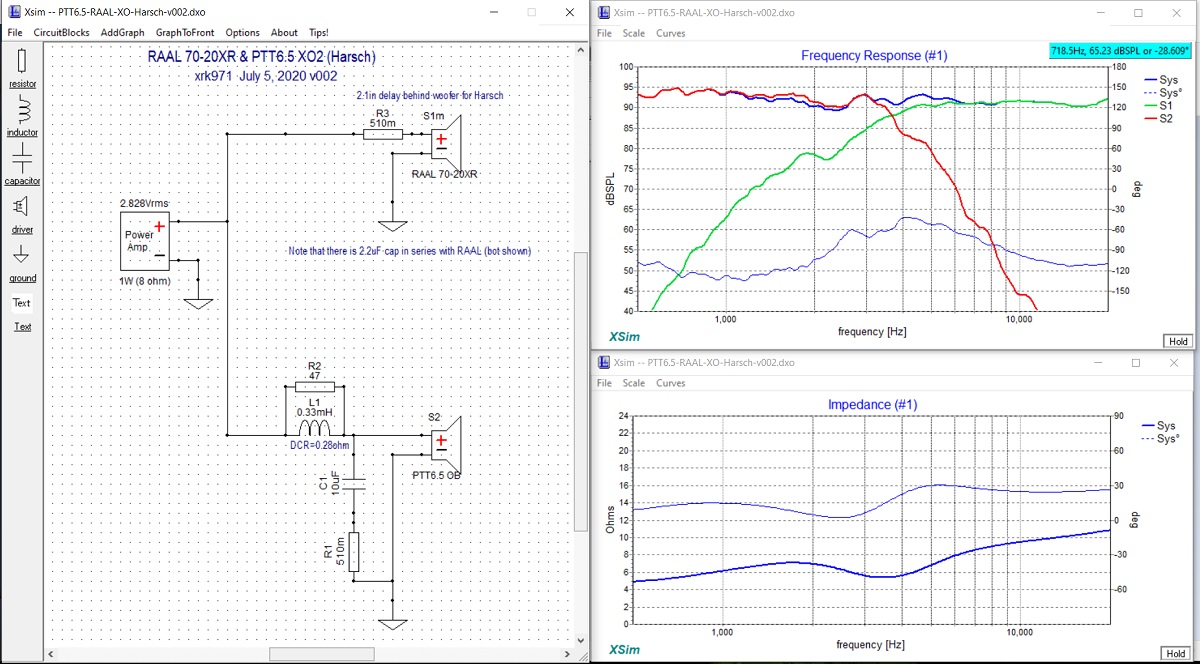
Attachments
Last edited:
It looks like Meniscus has been able to obtain the RAAL 70-20XR for the Bagby-designed Auricle and Testarossa kits. However, they do not carry the Purifi PTT6.5. One could possibly order the Auricle kit to get the 70-20 and set aside (or sell) the Satori woofer.
That Auricle looks like a nice speaker. The price they have for all drivers and XO is actually very reasonable. I bet I could make the Satori work in a TL like the PTT6.5.
I agree. I have built many Bagby designs and am currently finishing up the Helix dome/MTM design he did for DIY Sound Group (his last, IIRC - RIP). He said it was the best speaker he designed for them and others have rated it favorably against what is arguably his best-known design, The Continuum (LS3-5/A inspired).
Bagby also did a transient-perfect design, The Kairos, using the same Satori woofer as he did in the Auricle.
I am really interested in both your PTT6.5 builds. The TL with the RS28 tweeter looks fantastic, and this one does as well. Having built and calibrated the electronics on the veritable Meyer Sound HD-1 (former employee), I think both your designs compete well with that monitor.
This design with the flat impedance the 70-20 would lend itself to a nice active setup with a flea-powered SET driving the RAAL and perhaps a robust class-A SS amp driving the Purifi. One wouldn’t even really need DSP for the task.
Anyway, great work and thanks for sharing.
Bagby also did a transient-perfect design, The Kairos, using the same Satori woofer as he did in the Auricle.
I am really interested in both your PTT6.5 builds. The TL with the RS28 tweeter looks fantastic, and this one does as well. Having built and calibrated the electronics on the veritable Meyer Sound HD-1 (former employee), I think both your designs compete well with that monitor.
This design with the flat impedance the 70-20 would lend itself to a nice active setup with a flea-powered SET driving the RAAL and perhaps a robust class-A SS amp driving the Purifi. One wouldn’t even really need DSP for the task.
Anyway, great work and thanks for sharing.
Hi Brinkman,
Cool to know you worked for Meyersound. I have a lot of respect for Meyersound products and the founder. Ages ago, when I lived in Berkeley - those were some of the best times. Too bad I was not into audio back then or I would have looked up working at Meyersound for sure. I hope you try making one of these PTT6.5 TL designs. They sound so much nicer than a ported bass reflex.
Cheers,
X
Cool to know you worked for Meyersound. I have a lot of respect for Meyersound products and the founder. Ages ago, when I lived in Berkeley - those were some of the best times. Too bad I was not into audio back then or I would have looked up working at Meyersound for sure. I hope you try making one of these PTT6.5 TL designs. They sound so much nicer than a ported bass reflex.
Cheers,
X
That would be fantastic if there is already a premade waveguide. I didn’t even know they existed and was going to make one on Solidworks and 3D print it. Please let me know - much appreciated. It would be great if it was about a 2in deep waveguide. 🙂
I just looked it up and the RAAL waveguide was made for the 140-15D tweeter. Looks like you’re going to roll your own after all.
I can't find the specs on the 70-20 but notice the 70-10 is for sale at meniscus. Anyone know what the main differences are?
If the 70-20XR is unobtainable take a look at the Viawave SRT-7.
It measures better than the 70-20XR.
At HifiCompass you can compare the 70-20XR and the STR-7
It measures better than the 70-20XR.
At HifiCompass you can compare the 70-20XR and the STR-7
Waveguide for 70-20xr from Joseph Crowe.
I watched the video and blog post for this implementation. Not sure why he went with a bi-radial design vs an oblate spheroid waveguide. Nonetheless, the pattern control provided by the bi-radial horn is still an improvement over a flat baffle, even if I would have gone a slightly different route.
An advantage to 3D printing your own waveguide is that you can tailor the throat to your driver and your cut-off frequency to the driver being crossed over to. In this case, the Purifi is a 6.5” driver and likely starts beaming around 2670Hz so that is where you’re going to tailor your waveguide to match the off axis pattern.
The distortion measurements are interesting. I wonder how the amorphous core 70-20 compares in this regard.
I read the messages about distortion from the Youtube video. Apparently the diaphragm lost tension when the original faceplate was removed and needs to be measured again. So don't read too much into the distortion comments.
Last edited:
The WG300 waveguide I used with the RS28 matched the PTT6.5 almost perfectly. It looks like an oblate sheroid. I tried a tractrix with the RAAL and got a bunch of cancellation dips due to the near parallel sidewalls at the inner waveguide. But I never removed the faceplate to get close to the membrane.
Nano-Trynergy - a Compact Tractrix RAAL Ribbon Point-Source Horn
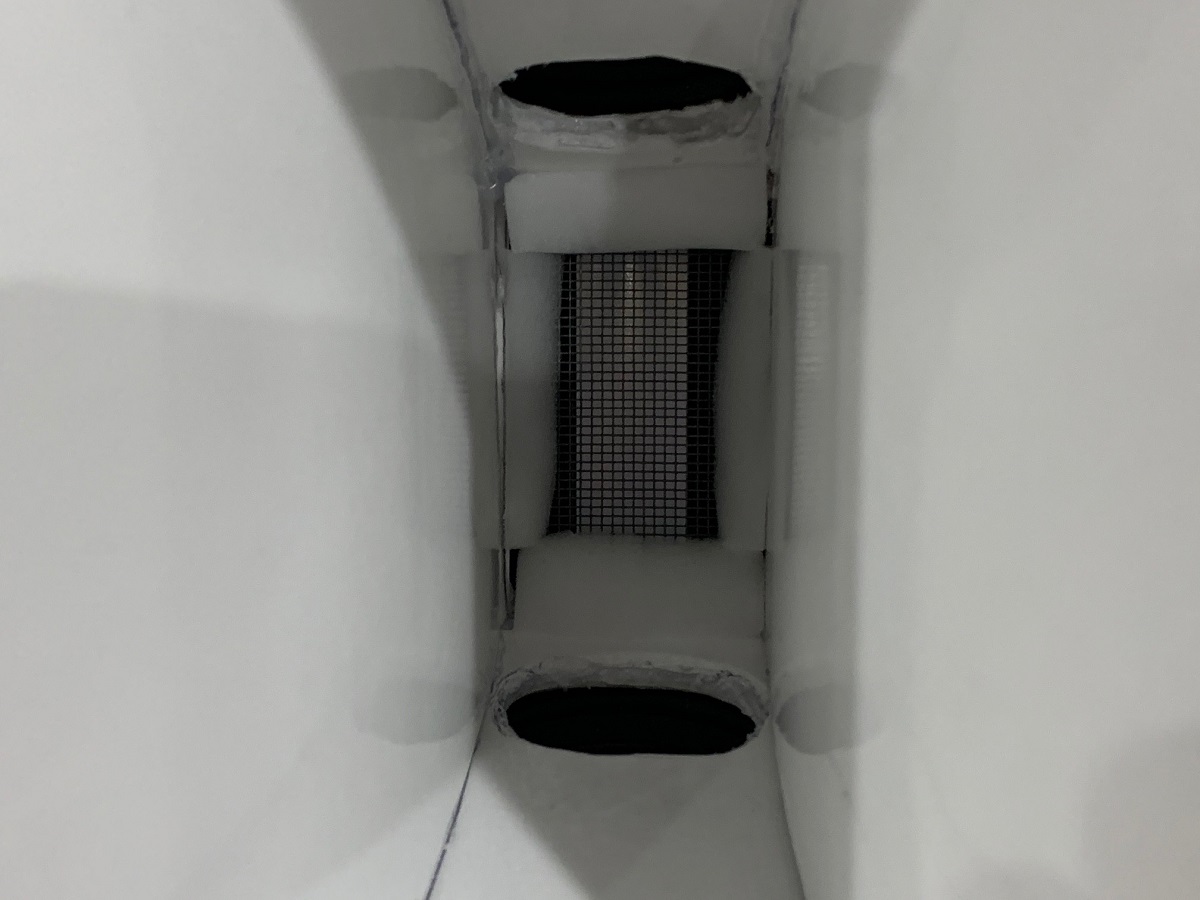
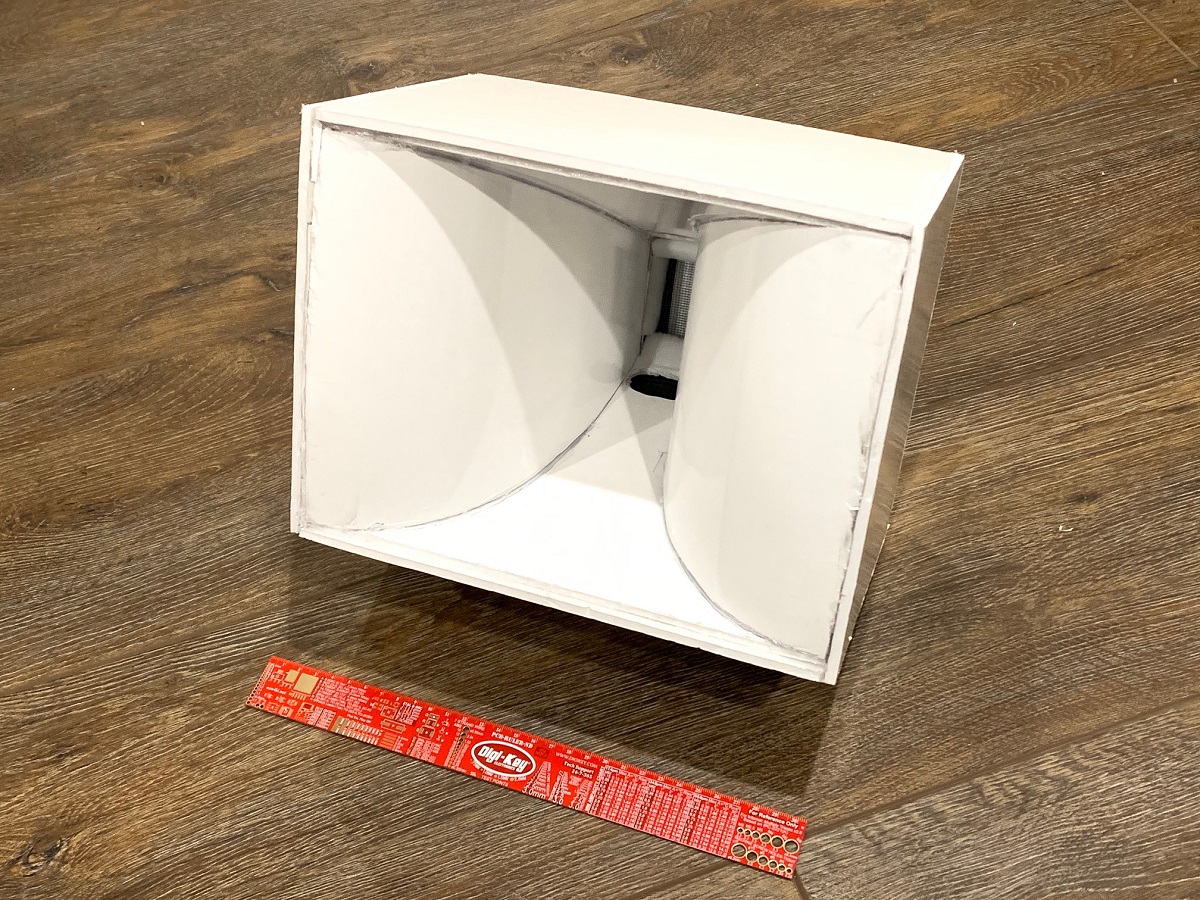
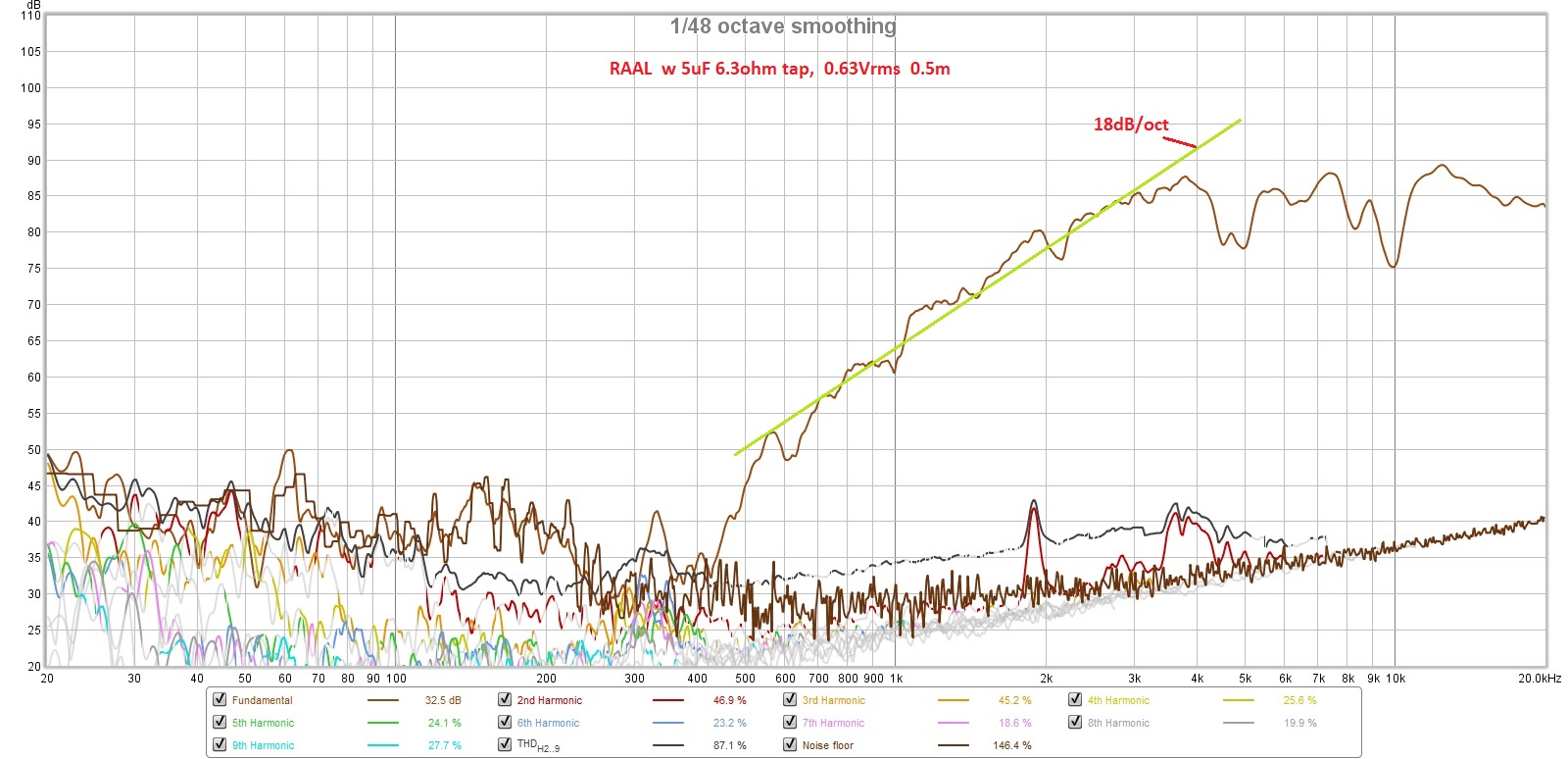
Nano-Trynergy - a Compact Tractrix RAAL Ribbon Point-Source Horn
- Home
- Loudspeakers
- Multi-Way
- RAAL 70-20xr and PTT6.5 Compact TL
